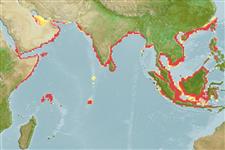Common names from other countries
分類 / Names
俗名 | 同種異名 | Catalog of Fishes(屬, 種) | ITIS | CoL | WoRMS | Cloffa
Teleostei >
Clupeiformes (Herrings)
鯡形目 (Herrings) >
Engraulidae (Anchovies)
鯷科 (Anchovies) > Engraulinae
Etymology: Stolephorus: Greek, stole, -es = garment + Greek, pherein = to carry (Ref. 45335).
Issue
Junior synonym Stolephorus baweanensis Hardenberg, 1933 is considered valid in CofF ver. 06 June 2023 following Hata et al., 2019 (Ref. 128121:11).
Environment: milieu / climate zone / depth range / distribution range
生態學
海洋; 半鹹淡水; 海洋洄游的 (Ref. 51243); 深度上下限 0 - 50 m (Ref. 189). 熱帶; 28°N - 9°S, 42°E - 123°E (Ref. 189)
Indo-Pacific: northern part of the Indian Ocean (Gulf of Aden, not Red Sea or the Persian Gulf, eastward to Burma) and western Pacific (Gulf of Thailand, Java Sea, also Hong Kong, Fujian and Taiwan Island; if correctly identified, then reaches to Fiji and Samoa) (Ref. 189). Mediterranean: Tel Aviv, Israel (Ref. 96660).
印度-太平洋: 印度洋 (亞丁灣而不是紅海或波斯灣, 向東至緬甸) 與西太平洋的北部 (泰國灣 , 爪哇海, 也香港,福建與台灣島; 如果正確地鑑定, 然後達到斐濟與美屬薩摩亞).
Length at first maturity / 大小 / 重量 / 年齡
Maturity: Lm 4.3, range 6 - ? cm
Max length : 8.0 cm SL 雄魚/尚未辨別雌雄; (Ref. 1602)
臀棘: 0; 臀鰭軟條: 17 - 20. Diagnosis: Body somewhat compressed, belly with 4-8 small needle-like pre-pelvic scutes; a small pre-dorsal spine in some specimens; maxilla tip pointed, reaching to or beyond hind border of pre-operculum, the latter concave, indented near maxilla tip; lower gillrakers 21 to 28; fine teeth on upper edge of hyoid bones; anal fin short, usually with 3 unbranched and 14-17 branched finrays, its origin below about middle of dorsal fin base; a double pigment line on back behind dorsal fin; tail deep yellow, at least in Indian specimens (Ref. 189). Of species with an indented pre-operculum, Stolephorus andhraensis has fewer gillrakers, 20-21, and S. ronquilloi has more gillrakers, 28-30; other species with a pre-dorsal spine also have a spine on the pelvic scute, like in S. dubiosus, S. baganensis and S. tri; hyoid tooth patches are present in S. commersonnii, but pre-operculum rounded, scutes usually 1-4, and in S. carpenteriae, but no pigment lines on back, anal origin under anterior part of dorsal fin base (Ref. 189).
腹面有 4 到 8個小的針狀鱗甲; 在一些標本中的一個小的前背棘。 顎骨頂端尖的, 延伸到或超過前鰓蓋的後部邊緣, 後者凹的, 在顎骨頂端的附近切割成鋸齒狀。 在 U 字形硬骨的上緣上的細齒。 一條雙色的線背面在背鰭後面; 尾部深黃色.(至少在印度的標本)
Coastal pelagic (Ref. 68964). A schooling species occurring in coastal waters. More data needed based on correct identifications. The record from the Godavari estuary implies tolerance of lowered salinities, but the identity of the material is uncertain (perhaps S. waitei). Appears to be fairly common throughout its range. Used as bait in the tuna fishery in the South Pacific, although rather fragile.
出現在沿岸水域的一個群游性魚種。 需要更多以正確的鑑定為依據的資料。 記錄從 Godavari 河口暗示低鹽度的包容,但是材料的鑑定不確定。 (也許 S. waitei) 似乎非常普遍在它的分佈範圍各處。 在南太平洋的鮪魚業當作魚餌了, 雖然相當纖細。
印度-太平洋: 印度洋 (亞丁灣而不是紅海或波斯灣, 向東至緬甸) 與西太平洋的北部 (泰國灣 , 爪哇海, 也香港,福建與台灣島; 如果正確地鑑定, 然後達到斐濟與美屬薩摩亞).
Whitehead, P.J.P., G.J. Nelson and T. Wongratana, 1988. FAO Species Catalogue. Vol. 7. Clupeoid fishes of the world (Suborder Clupeoidei). An annotated and illustrated catalogue of the herrings, sardines, pilchards, sprats, shads, anchovies and wolf-herrings. FAO Fish. Synop. 125(7/2):305-579. Rome: FAO. (Ref. 189)
CITES (Ref. 128078)
Not Evaluated
人類使用
漁業: 商業性; 誘餌: usually
工具
特別的報告
下載 XML
網路資源
Estimates based on models
Preferred temperature (Ref.
115969): 25 - 29.2, mean 28.5 (based on 816 cells).
Phylogenetic diversity index (Ref.
82804): PD
50 = 0.5000 [Uniqueness, from 0.5 = low to 2.0 = high].
Bayesian length-weight: a=0.00380 (0.00210 - 0.00687), b=3.15 (2.99 - 3.31), in cm Total Length, based on LWR estimates for this species & (Sub)family-body (Ref.
93245).
營養階層 (Ref.
69278): 3.3 ±0.4 se; based on size and trophs of closest relatives
回復力 (Ref.
120179): 高度, 族群倍增時間少於 15個月 (K=1.61-20.8).
Fishing Vulnerability (Ref.
59153): Low vulnerability (10 of 100).
